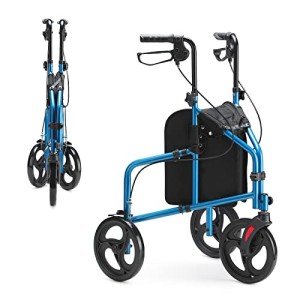10 Things That Your Family Taught You About Rollator Walker
페이지 정보
작성자 Santo Joiner 작성일 25-07-18 15:52 조회 35 댓글 0본문
Rollator Walker Safety: A Comprehensive Guide
As people age or face mobility obstacles due to health problem or injury, preserving self-reliance often becomes a concern. Rollator walkers, providing both support and mobility, have ended up being important tools for many. Nevertheless, while they provide numerous benefits, guaranteeing safety while utilizing a rollator walker is critical. This short article offers comprehensive insights into rollator walker safety, consisting of best practices, typical threats, and essential tips for users and caregivers.
Comprehending Rollators
A rollator walker is a mobility gadget with wheels that allows individuals to stroll with the assistance of a frame. Unlike standard walkers, rollators usually feature:
- Three or 4 wheels for easier maneuverability
- Hand brakes for stopping and managing speed
- A seat for resting when needed
- Storage compartments for bring individual items
These features make rollators ideal for both indoor and outdoor use, improving the quality of life for users by providing a sense of self-reliance.
Benefits of Using Rollator Walkers
- Increased Mobility: Rollators can assist users in walking around securely and easily.
- Support and Stability: With a sturdy frame and brakes, they provide vital support when standing or walking.
- Comfort: Many rollators come with padded seats, enabling users to rest as needed.
- Convenience: Integrated storage services can carry important products, freeing hands for better balance.
Common Hazards Associated with Rollator Walkers
While rollators can improve mobility and safety, they can also present risks. Users need to be mindful of possible dangers to minimize accidents:

- Uneven Surfaces: Rollators might topple if used on uneven or sloped surface.
- Braking Issues: Failing to engage the brakes sufficiently can cause falls.
- Excess Weight: Overloading the storage compartments can affect stability.
- Incorrect Use: Not using the rollator as planned can result in mishaps.
- Poor Maintenance: Neglecting routine look at wheels and brakes could result in failure during use.
Rollator Walker Safety Tips
To enhance safety while using rollator walkers, consider the following suggestions:

1. Proper Fit and Adjustment
- Height Adjustment: Ensure that the deal with height is set to the user's wrist level when standing upright. A correct fit motivates much better posture and control.
- Seat Height: If the rollator has a seat, guarantee it's comfortable and accessible for resting.
2. Regular Maintenance
- Examine Brakes: Make sure hand brakes are operating effectively. Change or replace them if required.
- Inspect Wheels: Regularly check wheels for wear and tear, and guarantee they spin freely.
- Take a look at Frame: Check for loose screws or cracks in the frame to guarantee it stays sturdy.
| Maintenance Task | Frequency |
|---|---|
| Brake examine | Weekly |
| Wheel inspection | Monthly |
| Frame assessment | Regular monthly |
3. Environment Awareness
- Clear Pathways: Keep living areas totally free from mess and obstacles that might posture a tripping risk.
- Lighting: Ensure that areas are well-lit to avoid mistakes, especially throughout evening hours.
- Prevent Slippery Floors: Be careful on wet or waxed floorings, as they can result in falls.
4. Safe Walking Techniques
- Engage Brakes When Stopping: Always engage brakes before sitting or while resting.
- Use Proper Walking Technique: Move slowly and preserve a consistent pace, taking actions that match the rollator's width.
- Balance While Turning: Turn thoroughly, utilizing the rollator for assistance as required.
5. Seek Assistance
- Include Caregivers: Encourage relative or caretakers to help in browsing difficult terrains or scenarios.
- Take Advantage of Community Resources: Many neighborhoods use mobility training for those utilizing walk-assisting devices.
FAQs about Rollator Walker Safety
Q1: How do I select the best rollator walker?
When selecting a rollator, consider the user's weight, height, and planned use. It's likewise vital to inspect for features such as hand brake effectiveness and wheel size, which can impact maneuverability.
Q2: Can I use a rollator walker on unequal surfaces?
While rollators can handle a variety of surfaces, it is best to avoid steep inclines, gravel, or cobblestones, as these can be harmful. Stay with flat, smooth surfaces whenever possible.
Q3: How can I avoid falls while utilizing a rollator?
Engaging the brakes when sitting, keeping paths clear, changing your rollator for the proper height, and bearing in mind your environments can considerably lower the risk of falls.
Q4: Are all rollator walkers the very same?
No, rollators can be found in various types and sizes, developed for numerous needs. Some may have additional devices like baskets, while others are lightweight or function a greater weight capacity.
Q5: Is it safe to carry bags on a rollator?
Always bear in mind the weight limitation and circulation of the load. Use the rollator's designated storage solutions and prevent straining it.
Rollator walkers are invaluable devices that enhance mobility and promote independence for users dealing with mobility difficulties. However, ensuring safety while utilizing these devices is essential. By comprehending prospective dangers, adhering to safe practices, and preserving the walker frequently, users can take pleasure in the benefits of their rollator with minimized threat. Eventually, the goal is to help with self-confidence and stability, making it possible for people to browse their world with security and ease. As care companies, member of the family, and communities prioritize safety, they empower users towards a better, more independent quality of life.
- 이전글 See What Car Keys Replaced Tricks The Celebs Are Using
- 다음글 20 Questions You Should Ask About Treadmills For Home Before You Buy Treadmills For Home
댓글목록 0
등록된 댓글이 없습니다.